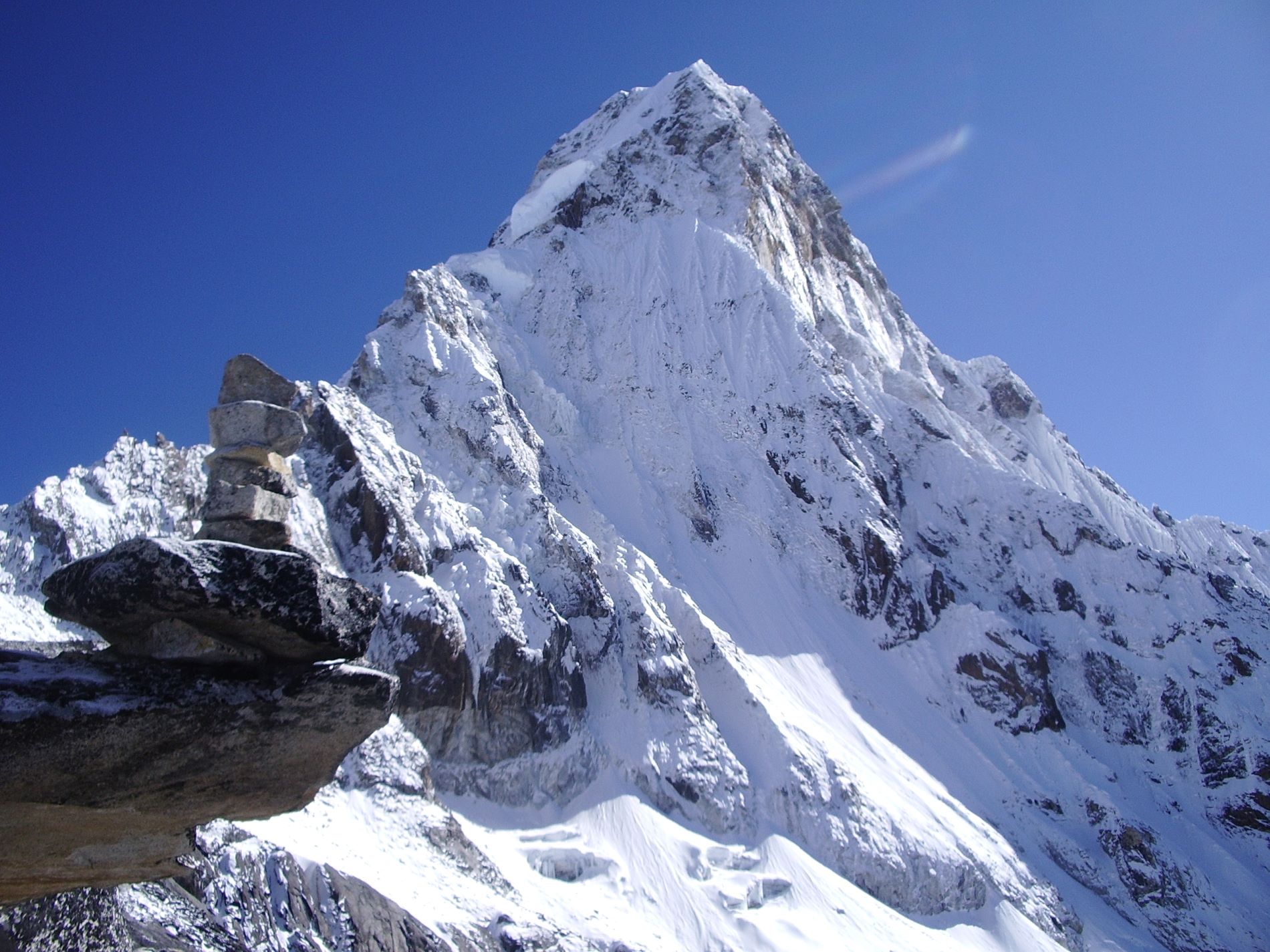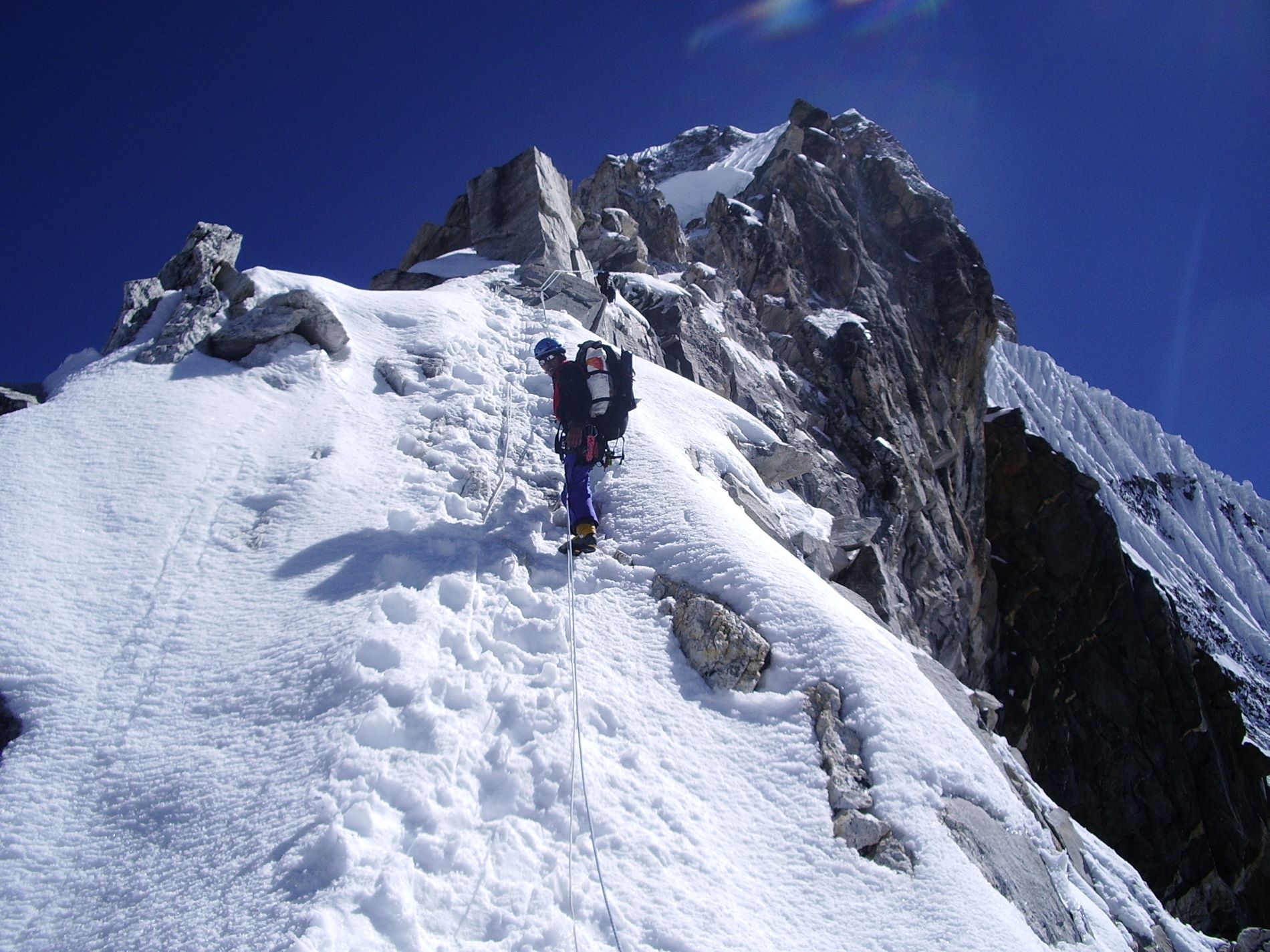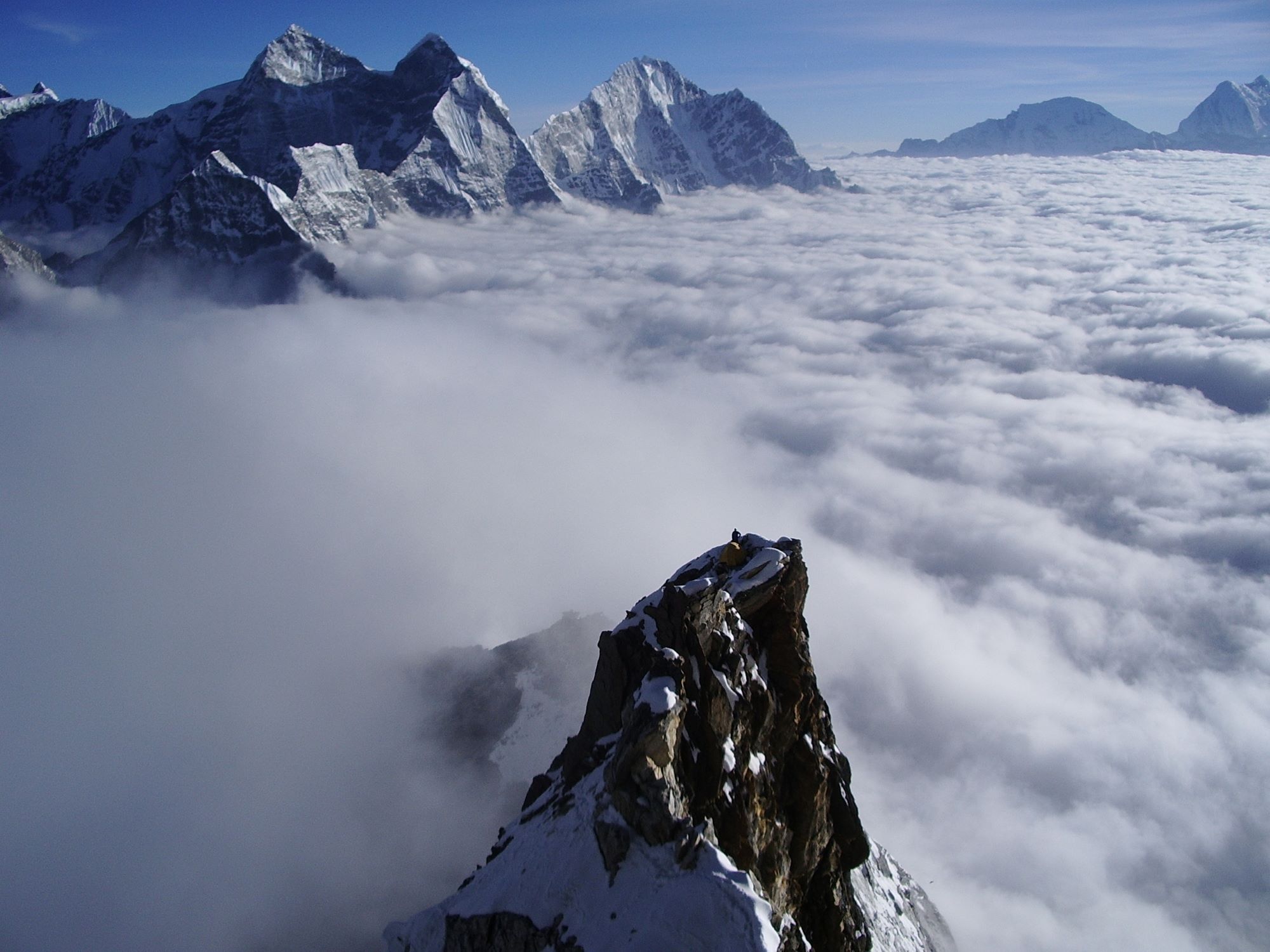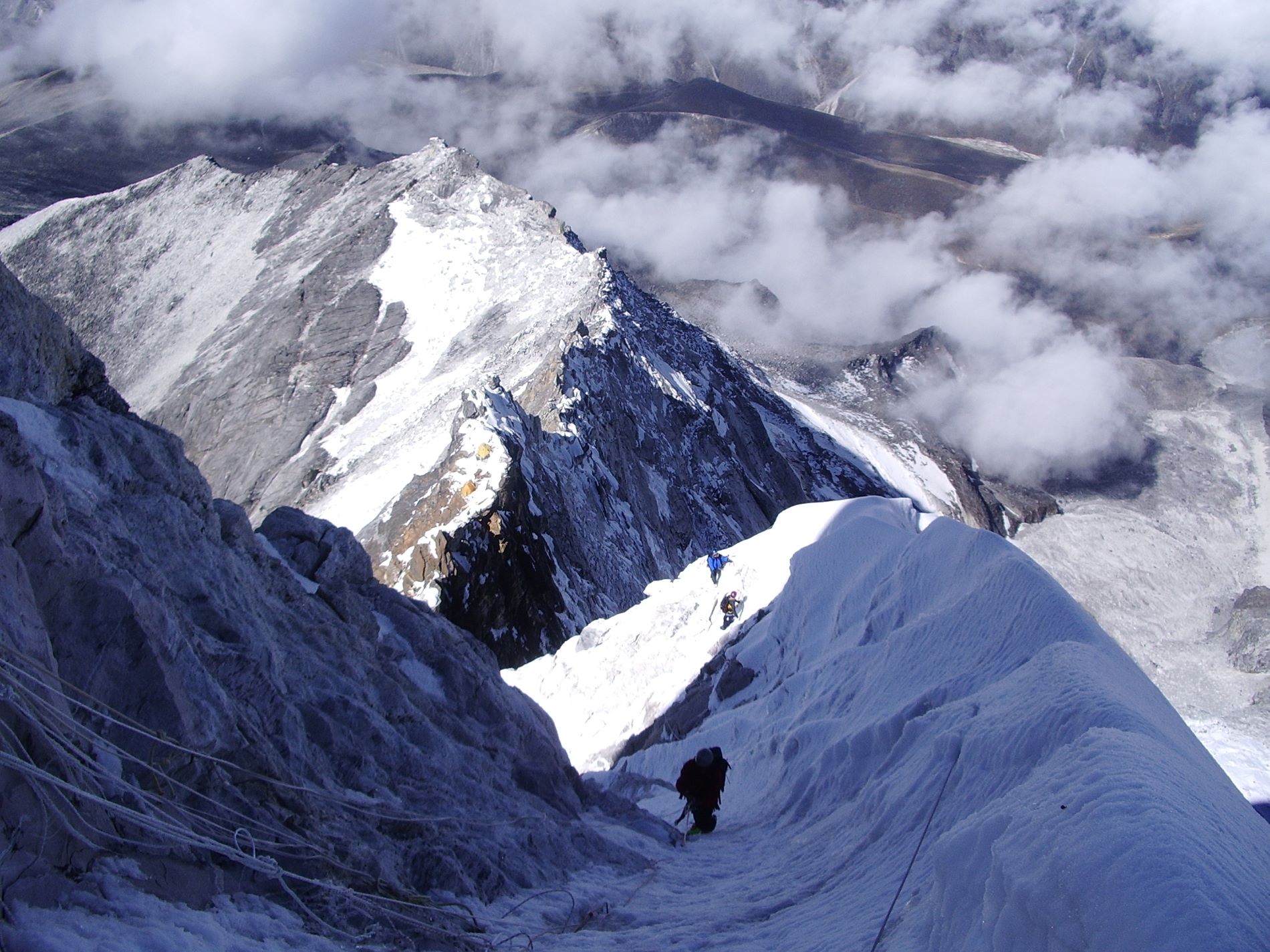Equipment List:
Climbing Gear
- Helmet: Must be able to fit over your ski hat
- Alpine Ice Axe: General mountaineering tool (65-70cm)
- Crampons: 12 points
- Ascender: 1 right or left-hand ascender
- A mountaineering harness, with adjustable leg loops
- Carabiners: 3 lockings and 6 regular*
- Rappel device: ATC or figure 8*
Clothing
Footwear:
- Mountaineering boots: suitable for above 8000m; Scarpa phantom 8000 or equivalent (This is because we can work under extreme weather conditions and also preparing you for your ultimate goal to climb Everest)
- Hiking shoes for the trek to base camp.
- Booties: Optional, down is best.
- Bridgedale Summit socks or equivalent: 6 pairs
- Bridgedale Liner socks or equivalent: 3 pairs
Body Layers:
- 2 merino base layers: top and bottom
- 1 mid-layer top: breathable
- Underwear
- Lightweight Nylon Pants: 1 pair
- Soft Shell jacket with hoody: To be worn over other layers
- Soft Shell Pants: Very breathable and water repellent
- Hard Shell Jacket with hood: A waterproof and breathable shell jacket
- Hard Shell Pants: Waterproof and breathable shell pants
- Insulated Down Jacket with hood: (fill power 800) or equivalent to Rab’s Electron Jacket. We primarily wear this when climbing below Camp 3
- Insulated synthetic Pants: Worn primarily when climbing below Camp 2
- Long jones equivalent to Rab’s Polartec or equivalent: 2 pairs
- Summit Down Suit
Headgear and Handwear:
- Warm Hat: Synthetic or wool hat (ski hat)
- Sunhat: To shade your face/neck from the sun on a hot day
- Buff: To protect your neck/face from the sun
- Glacier glasses: Full protection with side covers or wrap around
- Ski goggles: To be worn on summit day in the event of high winds
- Lightweight synthetic liner gloves: For wearing on a hot day; 2 pairs
- Softshell gloves: To wear for moderate cold/wind
- Shell glove with insulated liner: To wear for severe cold / strong wind
- Expedition Mitts
Personal Gear:
- Expedition Backpack: 65L pack should be large enough.
- Trekking Backpack: To carry on the trek to base camp. Simple and light.
- Sleeping Bag (for high camps): Rated to at least -40°F. Goose down or synthetic.
- Sleeping Bag (for base camp): rated to at least -20°F
- Compression stuff sacks: 3 large ones; for reducing the volume of the sleeping bag, down parka, etc., in your pack
- High-Quality sleeping pad (1 for base camp and 1 for high camps): Full length is preferred
- Closed-cell foam pad: To be used in conjunction with the inflating pad for warmth and comfort when sleeping
- Trekking poles with snow baskets: Adjustable poles
- Cup: Plastic insulated cup for drinking
- Bowl: A plastic bowl for eating dinner or breakfast
- Spoon: Plastic spoon
- Head torch: 1 normal for base camp and 1 with remote battery systems for climbing at night. This will be used whilst climbing at night
- Sunscreen: SPF 50 or above
- Lip balm with sunblock
- Water bottles: 2 wide mouth bottles with a 1-litre capacity
- Water bottle parkas (2): fully insulated with zip opening
- Thermos: 1 litre (buy a good one to keep your water warm for longer hours)
- Pee bottle: 1-litre minimum bottle for convenience at night in the tent
- Toiletry bag: Include toilet paper and hand sanitizer and a small towel
- Hand warmers & toe warmers
- Penknife or multi-tool (optional)
- Camera: bring extra batteries and memory cards.
- Personal solar charging system (optional but recommended)
- Travel Clothes: For days in-country
- Duffel bags (2) with locks: To transport equipment
- Base Camp Items: Kindle, I pad, smartphone, etc
- Snack food: Please bring a few days of your favourite climbing snack food such as bars, gels, nuts, beef jerky, etc. A variety of salty and sweet is good
- Small personal first aid kit: Include athletic tape, Band-Aid’s, Ibuprofen, blister care***, personal medications, etc
- Medications and Prescriptions: Bring antibiotics (Azithromycin, etc.), and altitude medicine such as Diamox and dexamethasone
Mt. Amadablam (6,812m) Expedition: A Complete Guide for Climbers
Climbing Mt. Amadablam, one of the most iconic peaks in the Himalayas, is a dream for many climbers. Rising to 6,812 meters (22,349 feet), it stands out for its sheer beauty and challenging technical climbs. Known as the "Matterhorn of the Himalayas," this expedition offers a unique blend of adventure, stunning scenery, and a rewarding summit experience. Whether you're an experienced climber or planning to take on your first high-altitude climb, Mt. Amadablam promises to be an unforgettable journey.
The Majesty of Mt. Amadablam
Nestled in the Everest region of Nepal, Mt. Amadablam is located in the heart of the Khumbu valley, surrounded by some of the world's highest and most revered peaks. For the Sherpa people, the mountain holds significant cultural and spiritual importance. "Amadablam" translates to "Mother's Necklace," named after the long ridges on each side (representing the arms of a mother) and the hanging glacier (the traditional pendant). To the climbing community, it's not just a peak but a sacred and revered climb that tests physical endurance and technical skill.
Why Choose Mt. Amadablam?
Compared to Everest or Lhotse, Amadablam offers a more intimate and technically demanding climbing experience. While it's not as high as Everest, the mountain provides climbers with thrilling challenges such as steep rock and ice climbs, exposure to sheer drops, and narrow ridges. What really sets Amadablam apart is the breathtaking panoramic view from the summit—one of the finest in the Himalayas, offering an uninterrupted vista of Everest, Lhotse, Makalu, and other towering peaks.
Expedition Overview
An expedition to Mt. Amadablam typically takes around 25-30 days, including acclimatization, trekking to base camp, and the summit attempt. The most popular route is the Southwest Ridge, known for its technical sections and stunning campsites perched on the ridges.
Base Camp to Summit: Key Stages of the Journey
-
Lukla to Base Camp: The journey begins with a scenic flight to Lukla, followed by a multi-day trek through the Khumbu Valley, passing villages like Namche Bazaar and Tengboche before reaching Base Camp (4,600m).
-
Base Camp to Camp 1: The climb officially begins with a steep ascent to Camp 1 (5,700m), a rocky ridge offering great views.
-
Camp 1 to Camp 2: From Camp 1, the route becomes more technical, involving steep rock sections and narrow ridges. Camp 2 (6,000m) sits atop a narrow perch, providing both exposure and beauty.
-
Camp 2 to the Summit: The final push includes mixed rock and ice climbing up to the summit. Reaching the summit of Amadablam is a climber's dream, with unparalleled views and a sense of personal achievement.
Best Time to Climb Mt. Amadablam
The ideal time to climb Mt. Amadablam is during the pre-monsoon (April-May) and post-monsoon (September-November) seasons. These periods offer stable weather, clearer skies, and manageable temperatures. The weather in the Himalayas can be unpredictable, though, and climbers should be prepared for sudden changes.
Physical and Mental Preparation
Climbing Mt. Amadablam is not for the faint-hearted. The physical demands are immense, and proper training is essential. Focus on endurance training, strength, and flexibility. Mental toughness is just as important, as climbers must remain focused and resilient in harsh conditions. Altitude adds another layer of complexity, and a slow, steady acclimatization process is key to preventing altitude sickness.
Technical Skills Needed for Mt. Amadablam
The climb requires proficiency in alpine climbing, including rock climbing, ice climbing, and the ability to handle technical terrain. Experience in high-altitude environments is strongly recommended. Many climbers train on smaller peaks or take preparatory courses to develop these necessary skills.
Cost of an Amadablam Expedition
The cost of an expedition to Mt. Amadablam can range from $8,000 to $15,000 or more, depending on the expedition company, services included, and your specific needs. Costs typically cover permits, logistics, guiding services, and gear transport, but there may be additional expenses for equipment, insurance, and personal gear.
Permit Requirements and Regulations
Climbers must secure several permits to scale Mt. Amadablam, including the Amadablam climbing permit and permits for the Sagarmatha National Park. These are mandatory and usually handled by your expedition operator.
Choosing the Right Expedition Company
Selecting a reputable expedition company is crucial for your safety and success. Look for companies with a strong track record of summits, experienced guides, and comprehensive support systems. Safety should always be the top priority, and it’s worth investing in a company with a proven history of successful climbs.
Safety on Mt. Amadablam
Climbing Mt. Amadablam comes with inherent risks, including avalanches, rockfall, and altitude sickness. Your guide will play a critical role in managing these risks, and climbers should follow all safety protocols, including proper acclimatization and hydration.
Essential Gear for the Amadablam Expedition
Packing the right gear is vital for success on Amadablam. You’ll need specialized equipment such as ice axes, crampons, harnesses, and helmets for the technical sections, along with high-quality cold-weather clothing, sleeping bags, and trekking gear.
Packing Tips for the Amadablam Expedition
It's important to pack smart for the Amadablam expedition. Keep your pack light but ensure you have all essential gear. Multi-use items, quality layering systems, and lightweight technical gear are key.
Post-Expedition Recovery and Reflection
After the expedition, recovery is essential. Climbers need to allow their bodies time to heal, especially after prolonged exposure to high altitudes. Mentally, the experience of summiting a peak like Amadablam can be transformative, offering a deep sense of accomplishment and personal growth.
The Mt. Amadablam Expedition Experience: Testimonials
Many climbers describe their Amadablam expedition as a life-changing experience. The technical challenges, coupled with the unmatched beauty of the Himalayas, create memories that last a lifetime.
Conclusion
In conclusion, Mt. Amadablam offers a thrilling and beautiful climbing experience for those up to the challenge. Its technical climbs, stunning views, and cultural significance make it one of the most sought-after expeditions in the Himalayas. For those looking for an unforgettable adventure, Amadablam is a must.








